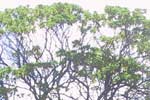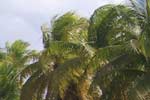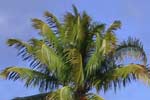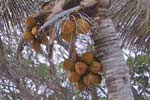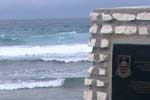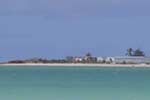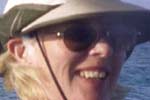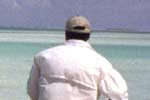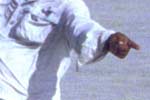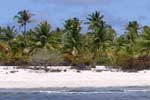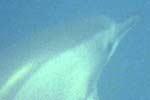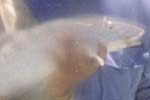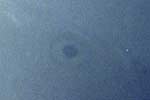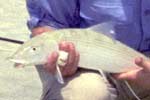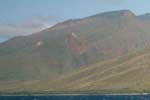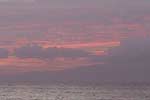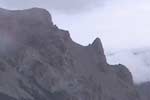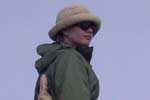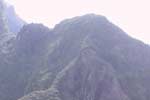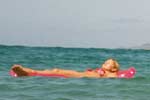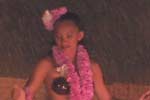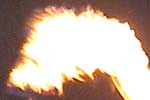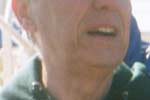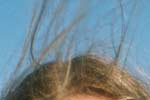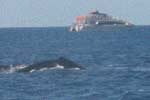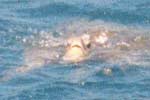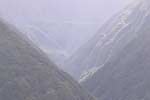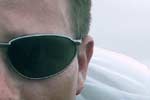
|
We like to pretend we love the rain. We love the cold and the ice. Really, though, wouldn't it be nicer if the temperature was nice enough to wear a t-shirt and shorts without fear of frostbite?
In February, 2002, we had enough and decided to head to the tropics. (Actually, we had planned this far in advance. After all, how can you just up and head on vacation without a bit of planning?) The plan was for John to accompany his father, aunt, and uncle to Kiritimati Island for a week of flyfishing. At the end of the week, John would fly back to Honolulu, say goodbye to his fishing partners, meet up with Amy, and fly to Maui for a week in Kihei. To answer your first question, Kiritimati Island (pronounced "Christmas Island") is the easternmost populated island in the Republic of Kiribati (pronounced "keer-ih-bahss"). It sits between one and two degrees north latitude, about 90 miles from the equator.
It's due south from Hawaii, yet to get there you must cross the international date line. Due to this jog in the dateline unpopulated Caroline Island (renamed "Millennium Island") was the first land mass to experience the year 2000. Kiritimati was the first populated island and there's a monument on the beach proclaiming the Republic of Kiribati the first in the new millennium. Kiritimati began its history when Captain James Cook landed there on Christmas Eve, 1777. In 1912, Father Emmanuel Rougier began planting coconuts on the otherwise desolate coral atoll. He and his colonists planted almost the entire island. There are only a couple of parts of the island where the trees don't grow in rows. There's only 125 square miles of land, but a population that continues to grow, mostly through migration from Tarawa, the capital of Kiribati. In the 1950s both the US and Great Britain used the island as a base from which to stage atomic bomb tests. Today, the authorities report the background radiation level on Kiritimati is lower than in most western cities. Cross your fingers for me, huh? So enough with the history lesson already. Kiritimati I left early the morning of February 9. I met my father at the airport for our flight to Honolulu. There, we met up with my Uncle Tony and Aunt Mary Ann (my father's brother and sister-in-law) before heading out on the town. Of course, we were a bit tired and a night on Waikiki was more of an early-bird dinner and crash in a cheap hotel. The next morning we arrived at the Honolulu airport at 4:30am to catch the once-a-week flight to Kiritimati. The 1,300 mile flight took about three hours. When we exited the plane we were exposed to the intense heat of the near-equator. Customs was a breeze even though I'd checked most of the boxes relating to restricted items. We gave our gear to a bunch of guys from the Captain Cook Hotel and jumped in a minivan. The hotel is really the old army barracks used during the atomic testing of the 1950s plus a few "bungalows" on the beach. It's not what you'd really call plush by western standards, but the barrack rooms have air conditioning and it's where the President of Kiribati stays so it's got to be good enough for a bunch of fisherman. (In fact, the President was due to arrive the week after we left. Dang.)
Of course, the reason we were on Kiritimati was to fish so we headed out within an hour of arriving. We started at Elliot's Flat and moved onto Princess Beach just across from the main town of London. The cloud cover was thicker than normal which made spotting fish very difficult. I spent pretty much the entire afternoon with the guide who would point to a spot 30 yards ahead of us and say, "Cast! 10 feet!" Well, my rod is about nine feet long so I'd cast a foot beyond that and he say, "No, farther! Cast again." I caught only one fish that first afternoon, but it was very gratifying. The next morning my Uncle Tony was pounding on our door. Since it was just a screen door (the island is virtually crime-free and it only drops to 80F at night) it rattled like crazy waking my father and me instantly, if not gently. Turns out the portion of the chalkboard where wakeup calls are written is an ongoing practical joke. There are no wakeup calls. Dang. At the hotel you get three truck days and four skiff days. On skiff days you take a truck to London (ok, so I guess you get three truck days and four truck/skiff days) and board a boat. The theory is that in the skiff you can get to flats out in the middle of the lagoon that are otherwise inaccessible. Never mind that one day after skiffing to a set of islands and saw a guy on a bicycle. "How'd he get here?" "On the road." Oh... good use of a skiff day. We started on Nine Mile Flat before moving on to others. I figured that after catching but a single bone the previous day I was due to catch lots of fish today. Unfortunately, they were conspiring against me. Many bones followed my fly, but each time one approached another kind of fish would take it. I caught three trevally (a great gamefish, but only when they're bigger than your hand), a snapper (tasty, according to our guide, but not really what I was after), and a Picasso trigger. I also broke off two bones and was able to knock just about all the rest on their heads with my fly. (You really don't want to do that. It makes the fish nervous and they tend to flee. You know, fight or flight.) As the boat pulled up for lunch I hooked a big one. It screamed out line as it headed into the coral-free deep off the edge of the flat and it looked good for our hero. Except that once in my backing (the part of the line that comes after the flyline designed to... oh never mind) it fell on itself, tangled, and the fish disappeared with my tippet. Argh. Happily, I caught several in the afternoon and avoided the skunk. We set precedent on the way back by convincing the guides to take us snorkeling. They took us onto the reef outside Cook Island where we saw oodles and oodles of aquarium-type fish. The government of Kiribati runs a fish harvesting business on the reefs. They pay about $1US to the locals to catch the fish. They're kept in small baskets in the reef and then packed up the day before being shipped to Hawaiian middlemen who pay $5US per fish. By the time a fish gets to The Fish Store in Bellevue it will sell for $100US. How's that for inflation?
Since the government owns the hotel they've mandated that different groups on the island need to maintain their cultural traditions. This means that ten rather embarrassed looking locals got the opportunity to perform their dances for us. Later in the week we'd have two more groups, one of which actually had one of our guides as a member. I almost forgot to mention that while we were flying around on the skiff we saw a pod of spinner dolphins dancing on the waves. Then it was a school of manta rays just under the surface. How do you forget something like that? The next day we fished Cats' Island (lots of feral cats running around - probably wise they only import and allow male dogs on the island) where I hooked a huge fish. Happy happy. After lunch we fished Whisper Flat which is of the "flat in the middle of the wide open ocean" type of flat. Not real featureful (is that a word?), but full of fish. I actually got a solo fish on the line, but couldn't land him. (This is significant because much of the challenge of bonefishing is seeing the fish and presenting the fly properly. Who cares about landing the fish? (Spoken like one who wasn't able to land the fish.)) I spent the evening tying flies to replace the multitude I had lost over the previous couple of days. I made a bundle of a pattern that was working really well (a "gotcha," mostly white with pearl flashabou and pink thread for any flyfisherman that care) and gave a couple to my father and a couple to Tony. I became popular. Our next truck day was only a half day because we were to head out on a blue-water fishing and diving expedition the next day. We fished Lone Palm in the morning which had few fish and none really memorable except a 10 pound trevally which instantly disappeared with my fly. Dive Kiribati is run by a guy named Kim Anderson who has lived on Kiritimati for the last ten years. He's a US citizen allowed to live on the beach because he's married to a Kiribati citizen. He's got a pretty good life, diving on fabulous reefs, living on the beach, fishing. Heck he's even got network connectivity via an Iridium phone. We fished in the deep blue water on the outside of the reef. We all picked up a trevally (Tony's 30 pound Giant Trevally was the biggest), but the real fun was in the diving. None of us are scuba certified so we were merely snorkeling, but we still saw incredible fish. As we were heading back in we saw a large pod of dolphin nearby which joined us and swam alongside the boat. Kim instructed us to all jump back in the water, but without our fins. We held onto the pontoon as he sped through the water. The dolphins again swam beside us, but this time we could see them underwater and hear them chattering to each other. As goofy as it sounds to say we swam with the dolphins it was really spectacular.
The next day we started at Orvis Flat, but the water was too deep. We headed to a brilliant white-sand flat called Motopua. We blind cast into the deep and picked up a bunch of bones and a couple "other" fish including a goat fish complete with "whiskers." The guide said they were especially tasty so he slipped it in his pocket for dinner. Speaking of dinner it was luau night. On Kiritimati that means you get to look a dead pig in the eyes after its been roasted for hours while a big guy with a knife stands over it hacking off bits for you. How sophisticated and tasty. With high winds the next day started out difficult. We boated to Smokey Flat where there were schools of bones coursing across the sands. We fished in one spot for almost an hour before moving down the flat. At the end we boated across a channel to Perry's Wharf where my dear father hooked and landed a monster of a bonefish. We shot loads of pictures, but it looks like there must have been water on the lens making most of them less than perfect. Dang. We ended the day by fishing Paris Flat which is great during full moons, but not so good during the day. (Amazingly, our guide walked through the very sharp coral in his bare feet. Ouch.)
Our final day of snorkeling was inside the lagoon where the water was calmer and surprising far richer in fish. The water was a bit warmer so we stayed in longer and generally had a great time. Our final day was a truck day at Submarine Flats where the rain smashed down on us making the fishing rather poor. We trucked over to Vasquez Bay which is on the west end of the island bordering on the ocean rather than the lagoon. We got lots of non-bones and a couple nice bones to finish our fishing for the week. Maui For the last week I was getting up at 5:30am to go fishing so what time would I naturally get up when I can sleep until eight? Yeah, that's right. 3am. Bugger. Oh well, I didn't need to be awake to spend three hours at the lovely Kiritimati airport or three hours on the plane to Honolulu. Amy and I were reunited which was quite joyful. Our place in Kihei was wonderful (thanks, Mom) with a great view of the beach. Speaking of which, we spent much of the afternoon there.
I woke up early again (damn) and did some shopping (ever see the price of milk on Maui?) and even found a Starbucks. I was disappointed that the entire island of Maui had fewer Starbucks than Issaquah, but it can't be perfect. We had Azeeka's Ribs with some of Amy's co-workers who happened to be staying at the same spot we were. It turns out vodka goes really well with passion fruit and guava juice. We heard that Mt. Haleakala was a wonderful place to see the sunrise from so we had decided to get up at 3am for the drive up to 10,023 feet. We got to the summit close to 10:30. (Come on, we're on vacation.) The view was wonderful, though a bit obscured by the clouds hovering about 1,000 feet below the summit. Made for some cool pictures, though. After surviving the road down (twists, turns, and crazy bicyclists) we headed to the other end of the island to hike the valley of Iao. Of course, I use the term "hike" loosely since it was completely paved and only about half a mile in total distance. The scenery was great, though, with a river running down the middle and lush tropical plants hanging over the "path."
We tried snorkeling a bit, but the clouds covered the sun and the wind chilled us to the bone. The fish were neat, though. Oh well, by the time we had left Ukumehame Beach the sun had come out for a few minutes by the pool. We did see a few humpbacks doing tricks in Ma'alaea Bay. Then dinner at "Margarita's" which turned out to be a Mexican restaurant with cheap lobster. What more could you ask for? The next day dawned overcast so we went shopping. We started at Starbucks (where else?), but then headed to a swimsuit shop. I know you're all fantasizing about me in a speedo, but sorry to disappoint, I was quite content in my shorts. Amy, however, needed a bikini to fit her beachy lifestyle. We were looking for blue, but came out of the store with a red so bright if it were a sportscar the owner would never be able to afford insurance. (That's really red.) We found a lovely pink blowup raft which seemed to hold a bit of air and at $1.95 it was cheaper than another frappacino so soon we were floating in the ocean off the beach. Unfortunately, the wind nearly drowned me so I retreated to the beach where the wind again tried to kill me, though this time with sand. It took Amy's genius to realize there would be no sand at the pool, but still plenty of sun. Well, duh. It was short-lived, though, since it was soon time to prepare for the luau. Holy cow, it's the most touristic of all events, but quite entertaining. The best part was the open bar. Ha, I kid I kid. The bar was lovely, but really the best part was the opening comic from Fiji. He had a sort of deadpan delivery reminiscent of Steven Wright, but a tad less depressing. You might think I was odd if I didn't mention the hula dancers, so is that enough? You happy now? Thanks. The fire dancer guy was pretty cool though. Or hot, actually, since he kept putting the torch to himself. I guess I could see how his feet could be able to take it, but his tongue? I can't even deal with half a star at the Indian bistro, this guy is my hero.
The next morning we got up amazingly early to get on a snorkeling boat for a trip to Molokini. Amy had seven layers on trying to keep warm in the cool morning breeze. I was being brave with just two, but really I was cold. Very cold. Teeth-chatteringly-can't-control-my-right-arm-cold. (That's cold.) In order to try to maintain what little body heat we had once we got in the water we both rented wetsuits. Best decision ever.
Our first stop was south of Kihei where a lava flow spilled into the water. The water was amazingly clear, far clearer than on Kiritimati, but far deeper as well. We frolicked for a while before the skipper declared it was time to move on to the next site. Unfortunately the next site was Molokini. Supposedly one of the greatest dive spots in the area, usually crowded with boats and up to 1,500 people floating like dead animals near the beach. On this occasion, though, we found the water whipped into whitecaps so old Captain Fluffy (I'm not making that up (well, actually, yeah I am, it was Captain Buzz)) decided we'd best head into the lee of the island for our final dive. The waves had been building all morning so our trip into the wind was less than pleasant. The water which seemed so warm when we were swimming seemed much more like ice when it was hurled at us by the wind. Someone described the experience as exfoliation, but I didn't think it was quite that bad. However, when we finally did get to a point where the sun came out most of us cheered and when it came time to get in the water no one was complaining it was cold. As we headed back to port after a fun dive and a BBQ on the back of the boat we near ran over a pod of three humpbacks which spouted and rolled less than 50 feet from the boat. We actually smelled something foul which may or may not have been from the whale. (Captain Fluffy didn't look like he was feeling all that well.) We also so a couple of turtles which continually popped their heads up to look right at us.
I dropped Amy back at the hotel for a bit more sun while I headed northwest determined to get some real hiking in. Waihee Ridge was my destination. The hike was a mere 2.5 miles to the top of Lanilili at 2,500 feet. The trail wound through lush forest before entering bogs and finally a high plateau grassland. At one point I stepped off the trail to look over a ridge down into the Waihee Valley and realized the ground dropped away about 1,000 feet below my feet. I quickly retreated. My photographic skill showed its true nature as I stared into the lens trying to determine why it wasn't shooting... as it shot. Behold, me, up close. Sorry about that.
We shopped the end of our trip away in Wailea, but found little of interest other than the photos from Kiritimati and a sarong both Amy and the saleslady thought was wonderful. Looks like another piece of fabric to me, but oh well. The next day was all boring flights home landing us in a cold, windy Seattle around 10pm. The next morning it snowed. Welcome home. When's the winter end? Congrats. You made it to the end. |
© 2002 moosefish.com
